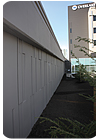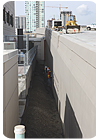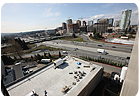
The
eastern approach and the medical center both utilized expanded polystyrene
geofoam.
There is no doubt that traffic is an ever-increasing problem, especially in metropolitan areas. The city of Bellevue, Wash., is no exception.
Over the past few years, Interstate 405 in Bellevue has posed an increasing problem: traffic congestion that has significantly increased the number of accidents and the time spent in travel. Currently, I-405, as the main bypass around the east side of Lake Washington, has a daily traffic congestion of six to 10 hours and costs millions in wasted time and fuel.
In an effort to diminish this economic and environmental strain by reducing traffic congestion, the Washington State Department of Transportation (WSDOT) designed a three-year environmental impact statement (EIS) development process that includes roadway construction and transit and environmental programs that incorporate more than 300 improvements. The EIS was approved in October 2002, and the I-405 Corridor Program was established.

Geofoam provided the seismic stability that
was necessary for the project’s location. There were only a few feet on each
side of the project between existing buildings.
At its completion, the I-405 Corridor Program is estimated to save more than 13 million hours of travel time each year, an annual savings of $569 million. An additional $42 million will be saved by the reduction of traffic accidents. The ultimate goal of the I-405 Corridor Program is to make travel on I-405 safer and more efficient, to facilitate commuter traffic, and to improve the environmental health and stability of the surrounding area.
One of the projects in this program consists of the construction of a new freeway bridge over I-405 at NE 10th Street, which runs through downtown Bellevue. This project is being constructed in two stages: the NE 10th Street extension and the NE 10th Street bridge crossing. Upon completion, this project will create a new connection over I-405 between 112th Avenue NE and 116th Avenue NE. This new configuration will improve the flow of traffic through downtown Bellevue and improve downtown access to and from the freeway.
The First Stage
The first stage, which began in December 2006, will extend NE 10th Street from 116th Avenue NE, between the South Tower of Overlake Hospital Medical Center (OHMC) and Group Health Cooperative to the eastern side of I-405.
This stage, managed by the city of Bellevue, includes the construction of the eastern approach to the new overpass bridge that will cross over I-405 and will incorporate more than 11,000 cubic yards of expanded polystyrene geofoam fill. This construction will include an abutment for the bridge, an intersection at the entrance to OHMC and Group Health Cooperative and a pedestrian tunnel that will run underneath the roadways, providing sheltered foot traffic between the healthcare facilities.
The overpass portion of this project will provide safer and less congested vehicular and pedestrian crossing over I-405, reduce congestion on NE 8th Street by splitting traffic between alternate routes and improve access between downtown Bellevue and the medical district. This five-lane bridge structure will incorporate 12-foot-wide sidewalks.
Project Design
In order to design and implement the NE 10th Street Bridge project, WSDOT partnered with the city of Bellevue. The project design was completed by WSDOT’s I-405 Project Team, which is leading the development of congestion relief and rapid bus transit projects along the I-405 corridor, which covers a span of 30 miles. As a general engineering consultant team, the WSDOT group is utilizing HNTB Corporation as the prime consultant and HDR, Incorporated, located in Bellevue, and Parsons Transportation Group as the two main sub-consultants.
For the first stage of the project, the city of Bellevue contracted with Scarsella Brothers, Inc., a contractor based out of Seattle. Scarsella Brothers bid $7.1 million for the job, a bid that was approximately 14 percent below the engineers’ estimates. This significant difference can be partially attributed to the use of expanded polystyrene (EPS) geofoam fill in the first phase of the project, as geofoam products significantly reduce construction time, when compared to the use of standard fill products, such as dirt.

The goal of the I-405 Corridor Program is to
make travel on I-405 in Bellevue,
Wash., safer and more efficient,
to facilitate commuter traffic, and to improve the environmental health and
stability of the surrounding area. The eastern approach will connect to an
overpass bridge that will cross over I-405. (Photos courtesy of Insulfoam.)
The city of Bellevue chose to use geofoam fill, which was supplied by Insulfoam, the nation’s largest manufacturer of block-molded expanded polystyrene, headquartered in Tacoma, Wash. The project incorporated Insulfoam’s InsulFoam GF (Geofoam), types EPS 22 and EPS 29.
InsulFoam GF proved to be the ideal product for the NE 10th Street Bridge, providing a highly resilient, lightweight fill alternative. The overpass bridge presented a unique design challenge, as it was constructed between two existing buildings, the OHMC, which is currently undergoing reconstruction, and Group Health Cooperative, which is being newly constructed. There were only a few feet on each side between the existing structures and the sides of the bridge, leaving minimal construction flexibility. While planning the construction, the I-405 design team discovered that the foundation of the new OHMC tower would not be able to withstand any added surcharge that might be created by the approach embankment of NE 10th Street, a primary reason that the lightweight geofoam was such an ideal material for the ramp’s construction.
“As it had already been constructed, our design team was faced with trying to determine a way to provide additional support to the OHMC structure, or determine some other way of minimizing or eliminating loads,” said Ron Ohlsen, vice president of HDR and contract manager for the I-405 Corridor project.
With this to consider, the design team had to find a method of providing additional support to the OHMC tower or eliminating any additional loads that might be placed on the building. After considering various fill options for the bridge approach, the team specified geofoam products, as they were lightweight and had the ability to bear the complete load of the road while eliminating any side load that might be placed on the foundation walls.
The use of geofoam not only provided a solution for the existing OHMC structure but also enabled both of the construction projects to progress simultaneously, without creating any additional complications.
“With the use of geofoam, there was no added surcharge to the adjacent building, and both construction projects, on the bridge and the medical center, were able to move forward,” Ohlsen said.
Easy Installation
The application of geofoam also provided an easy installation, as only a few feet of existing material had to be removed in order to place the 30 feet of geofoam for the bridge approach. The geofoam used was manufactured in 40-inch by 48-inch by 192-inch blocks, facilitating a quick installation and significantly reducing the overall construction time of the project. The use of geofoam also reduced the amount of truck loads required to transport the fill material to the jobsite, minimizing impact on the transportation system, the pavement and the traffic circulation.
As a highly resilient product that features enhanced resistance to water absorption, geofoam also provided the waterproofing needed to protect the bridge from inevitable moisture buildup and extreme weather conditions. The application of geofoam eliminated the need for waterproofing membranes or other products that are often necessary for below-grade structures that are exposed to excessive moisture buildup.
The geofoam installation began with the construction of the bridge abutment and two fascia panels, which replaced the retaining walls that are typically used in embankment applications. After the walls were put in place, a layer of sand was poured into the fill area. The preformed geofoam blocks were then installed in alternate layers, providing minimal continuity of vertical joints between the blocks. For the final layer of geofoam, full-size blocks were custom-cut on the jobsite to create the required construction profile.
During the geofoam application, roadway loads were calculated based on a section of fill, and an equivalent amount of heavier existing soil was removed in order to create a zero net load on the ground and existing structure. After the geofoam blocks were laid, rebar was put in place and a distribution slab was installed in order to attach the head and sidewalls and complete the foundation for the roadbed. The geofoam application required less than three months of construction time, beginning in June of 2007 and ending in August of the same year.
Environmental Benefits
The use of geofoam not only decreased construction time but also provided the environmental benefits that both the state of Washington and the city of Bellevue were looking for. As a fully recyclable product that does not contain any formaldehyde or ozone-depleting CFCs, Insulfoam’s geofoam offered a high-performance, eco-friendly alternative.
The second stage of the project is still under construction and is expected to be open to traffic in 2009. With this new construction, as part of the massive I-405 Corridor project, the traffic congestion in the Bellevue area will be greatly improved and the travel will once again be safer and more efficient. With this project, the city of Bellevue and the state of Washington are taking a major step towards improving and streamlining overall transportation, not only making everyone’s lives easier and more efficient, but also improving the health and safety of the environment, one road at a time.